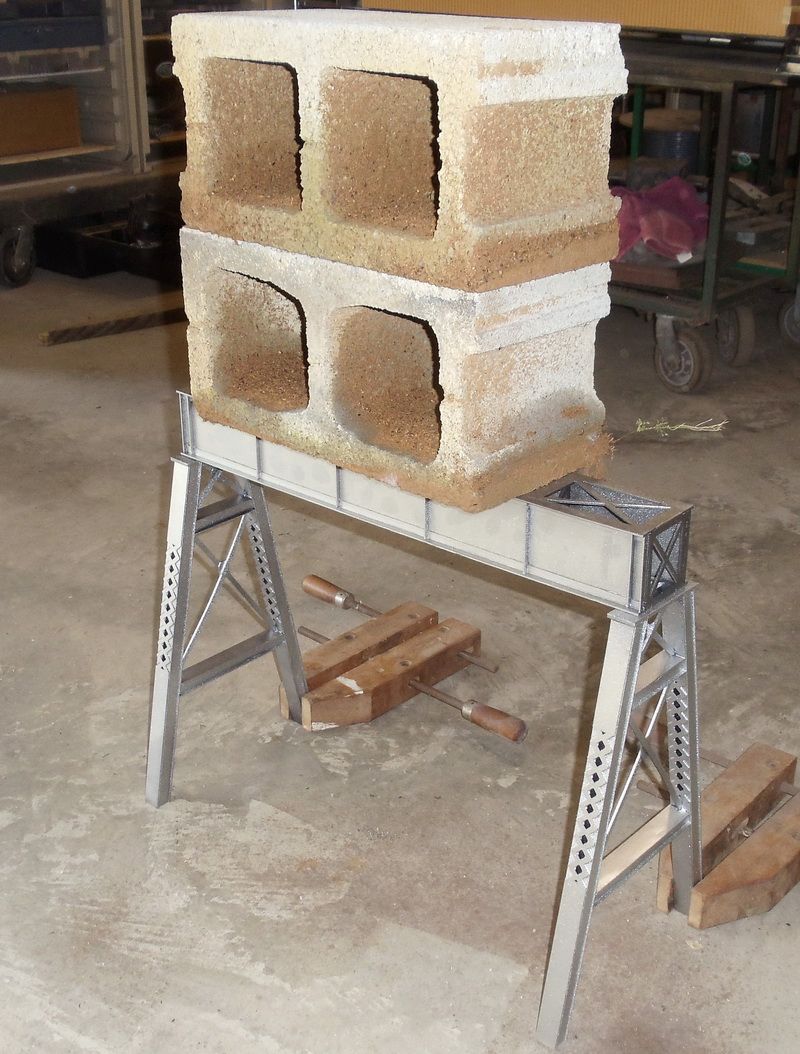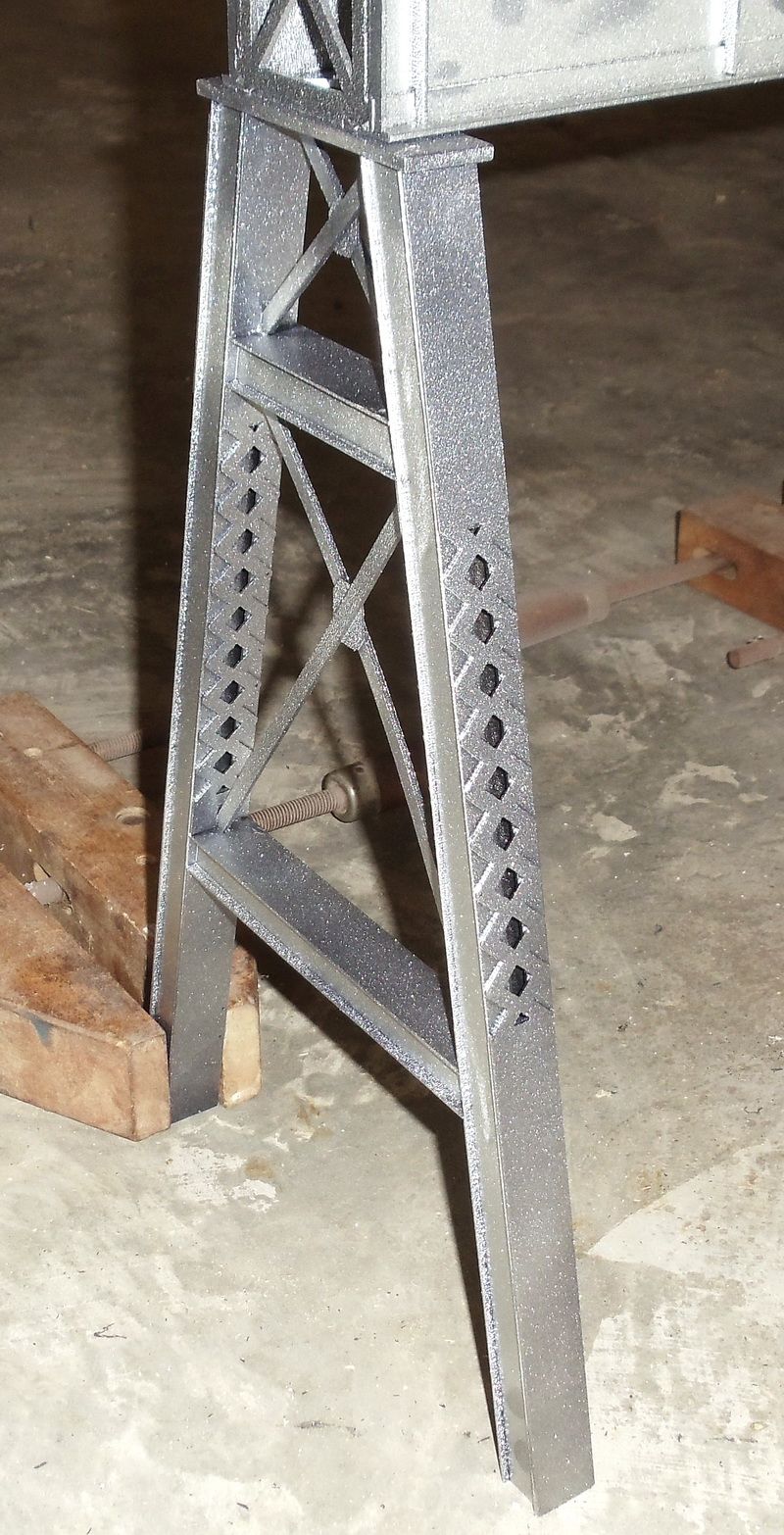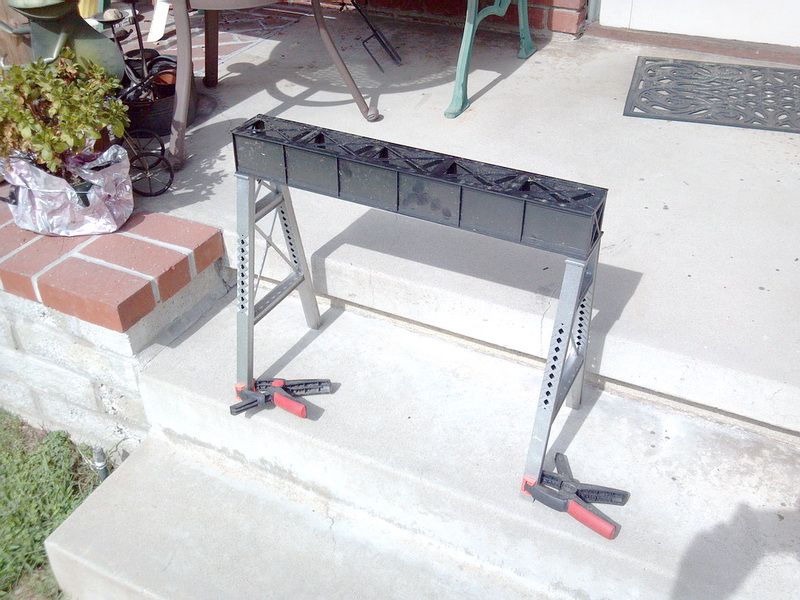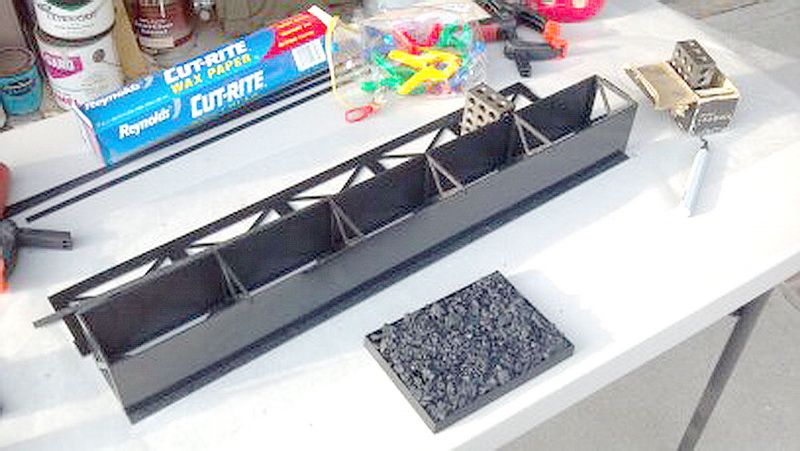Gary Armitstead said:
Eric Reuter said:
Has anyone used the line of bridges offered by SplitJaw? I have a long elevated section of track that I need to build, connecting my indoor and outdoor layouts. I’m looking at their through-girder bridges for this. They have some incredibly long spans (up to 8’), and I’m wondering if they are up to the task of carrying a 40 lb engine like the Hudson.
Well I do have experience with these bridges and I bought a 48" drop girder about 9 or 10 years ago (as an experiment
). At that time they were about fifty bucks each. I know that Split Jaw says they are paintable PVC…I thought the material was more like “glorified” heavy duty packing used to hold electronics products from moving around the shipping box :)! I would give you mine, but it would cost more to ship than it"s worth. A year after I purchased this product, I contacted Scott Lindsay in Tennessee and had him make me custom bridges (also drop girder). He makes up custom kits where the parts are ABS and cut with an NC router. They go together very easily. You use the same glue as you would use for ABS plumbing. Very detailed and stronger than the Split Jaw products.
Greg I think the confusion is because of a similarity between the 2 companies mentioned. Eric was asking about Split Jaw and you and Gary replied about JS Railcars bridges, which I accidently transposed the letters and added the &, calling them J&S, my mistake . I was wondering if Split Jaw had addressed Gary’s comment on the strength and thickness of their product.
Thanks Pete!
Yeah, I agree on your assessment of the Split Jaw material. I will buy some of their walk on railbed, but I was under the impression it was solid PVC, at least what I saw at their booth at shows, but perhaps I better double check?
Greg
Those bridges are great. As my rebuild progresses, next year I will be rebuilding my big trestle, and those curved beams might just be the ticket. Though I’d have to figure out the degree curve.
Regarding Jerry’s bridge, it is actually 20 feet long, I bought a commercial product, 2 x 3 inch aluminum at a metals supplier
the concrete piers are not exactly dummies, they were cast inside an old no parking sign bent to shape, with a 1/2 inch dia threaded rod inside them.
There are 7 piers, and they do hold up the bridge, and I could have used less of them but I liked the way the spacing looked to the eye.
Then put into the ground into a pool of concrete with one inch of the rod above the top of the column
I then drilled holes in the bottom of the Al beam and dropped it onto the piers. Added polystyrene angles for a little detailing.
Jerry
I need a curved deck bridge, so I will be contacting J&S… the wooden trestle I have is not really “kosher” (https://www.largescalecentral.com/externals/tinymce/plugins/emoticons/img/smiley-surprised.gif)

Greg Elmassian said:
Pete, a little confused, I may be wrong, but I interpret Gary’s comments as on the J & S Railcars products. But you talk about changing the materials. That’s solid ABS, so are you looking at better than ABS?
The SJ (you put S&J) has material that looks to be like it would not be as sturdy as the solid ABS. (My opinion based on the look and what others have said about the SJ roadbed products, which seem to be some kind of structural foam)
Greg
There seems to be a lot of confusion about my comments on the companies making bridges! My original comment to Eric regarding MY experience with Split Jaw bridges were that they were made of a PVC type material that was not much more than “glorified packing material”. I didn’t like the 48 inch deck bridge that I purchased 8-10 years ago and the bridge still sits in a corner of my garage gathering dust to this day. I tried to give it away to some local LS folks in this area (along with the two piers I bought for it and had NO takers :)! That should tell you about the quality. I can’t make it ANY clearer than that. I know they are still made by Split Jaw (under new ownership I believe) and its still the same material. Confusion cleared up?
The ABS bridges from Scott Lindsay (on the other hand) are better quality, stronger, more detailed and are fairly inexpensive. I would definitely recommend them.
Bob McCown said:
Those bridges are great. As my rebuild progresses, next year I will be rebuilding my big trestle, and those curved beams might just be the ticket. Though I’d have to figure out the degree curve.
Bob,
Scott will figure out the angle for you depending on the radius you need. He HAS to do that because he has to make the program to run the NC router to cut it.
Bob McCown said:
Those bridges are great. As my rebuild progresses, next year I will be rebuilding my big trestle, and those curved beams might just be the ticket. Though I’d have to figure out the degree curve.
Bob,
Scott will figure out the angle for you depending on the radius you need. He HAS to do that because he has to make the program to run the NC router to cut it.
Scott is about to have a busy spring. I should ask for a commission!
I found a few photos of the deck bridges that Scott sent me BEFORE I purchased any from him. Note the cinder blocks stacked two high on a 18 inch long bridge with ABS piers he made for me as an example of his work.



One of my completed 24 inch deck bridges on Scott’s piers.
During construction and assembly of one of Scott’s 24 inch deck bridges.

Gary Armitstead said:
Bob McCown said:
Those bridges are great. As my rebuild progresses, next year I will be rebuilding my big trestle, and those curved beams might just be the ticket. Though I’d have to figure out the degree curve.
Bob,
Scott will figure out the angle for you depending on the radius you need. He HAS to do that because he has to make the program to run the NC router to cut it.
It being flex track, the radius I need is “yes”.
I need to do some surveying and see if I can get one or maybe two separate radii for this curve.
Maybe use a rail bender to match the bridge?
For those who have had the J&S Railcars PVC bridges, do you glue them together? Normal PVC glue? (I know you can use metal pins in the gusset plates, but surely that is not bearing the load alone.
Greg
Greg Elmassian said:
Maybe use a rail bender to match the bridge?
For those who have had the J&S Railcars PVC bridges, do you glue them together? Normal PVC glue? (I know you can use metal pins in the gusset plates, but surely that is not bearing the load alone.
Hi Greg,
FIRST of all, J&S Railcar bridges are ABS, not PVC…
AND the metal escutcheon pins used in the gussets is only to represent the rivets. The holes are pre-drilled by Scott for these pins. Rick Marty actually put these thousands of pins in place! Glutton for punishment! I NEVER put these pins in place. The bridge can take the load with glue ONLY. Believe me, they are very, very strong. My son has stood on the 24 inch deck bridge suspended between two 2X4’s and the bridge held. He weighed about 150 pounds at the time (just returned from Iraq a few years before).
Having a family of plumbers helped a lot when getting the correct glue for my bridges.
You cannot use PVC cement on ABS. And you can’t use ABS cement on PVC. They just don’t hold at all. As to do with how the cement “welds” or melts the material to fuse together. On the ABS bridges from Scott, he already warned me about the difference in the two glues before I ever started. Just used the ordinary black ABS cement from Oatey (common name brand used by plumbers). There is a third glue called Transition cement made to glue transition couplings between PVC and ABS. It’s colored green. I tried it on one of my deck bridges to experiment with a PVC catwalk (before I bought the Garden Metal Catwalks). Didn’t work at all or was consistent in holding the catwalk. When you do decide to build these ABS bridges, make sure to get some smallish plastic bottles to dispense the glue onto the parts. For the bigger parts, use a 6-8 oz. plastic bottle to squeeze the glue in place. It’s a little tedious (stressful) when you first start to glue these. Have every part you are about to assemble organized and ready to put in place before putting even a single drop of glue on a part :)! Once the glue is on the part, you have about 6-8 minutes of working time before the glue sets up and cannot be moved or separated! You get the rhythm pretty quickly and you can move fast. It took me about 90-120 minutes to completely assemble the 4 foot arch bridge. A fair amount of that time was waiting for the glue to set up enough to continue the remainder of the assembly. Sometimes Scott sends extra pieces as a courtesy to have replacements available in case you damage a part in the gluing operation.
A couple of things to know about Scott’s bridges. One thing is that the bridges can literally be put together WITHOUT any glue. He machines tabs and slots in adjoining parts so everything is mated together. Make yourself very familiar with every part and where it goes in the completed bridge. IF a part doesn’t fit or go together without forcing, then it’s the WRONG part for that area. These bridges are almost foolproof. He does a remarkable job in “engineering” his stuff :).
As far as attaching various deck bridges together, that is something YOU have to engineer yourself. My “curved” deck bridges were about 17 3/4 inches long measured down the center of the structure. End end is angled in relation to the radius of the curve (think of the bridge as a short chord of the radius). You HAVE to mount a pier under EACH bridge joint!! As far as gluing the bridges together, I didn’t do that. I used 1/8 or 3/16 diameter steel dowel pins (available from McMaster-Carr or other industrial supply house. Lowes or Home Depot might even have them). Let the bridges “float” on the piers like the prototype. Anchor the piers securely! This is the point where I went back into 1/8th scale ride-on hobby. Because I was going to elevate my layout quite a bit higher than originally designed (I went from ground level which made the pier height over a lower garden area about 18 or 20 inches, to about a pier height of over 40 inches. This entailed going to a different type of center joint pier. Single pier to a box structure pier similar to some of the very tall bridges on the Cumbres & Toltec, namely Cascade Trestle. Scott was working on a design for me at that time (2013).
I know this wa a little “long-winded”, but hey that’s me. Hope this helps with your bridge complex in Carlsbad.
Eric Reuter said:
Has anyone used the line of bridges offered by SplitJaw? I have a long elevated section of track that I need to build, connecting my indoor and outdoor layouts. I’m looking at their through-girder bridges for this. They have some incredibly long spans (up to 8’), and I’m wondering if they are up to the task of carrying a 40 lb engine like the Hudson.
The 8’ spans intrigue me (support wise) …actually this thread inspires me period but I still like my steel bridges and how they weather naturally! Although the faux concrete viaduct is weathering quite nicely.
Thank you very much Gary, and yes I forgot it was ABS and not PVC (I have one each of all those glues including the transition glue, black, clear, blue, green and purple primer)
Nothing long winded, all very helpful.
Greg
Did some radius measurements today. The majority of the bridge is about 76” radius, and the last six feet or so is so shallow of a curve that I could use a straight bridge there.
Thats encouraging
I have 3 of the 10 foot diameter 30 degree PVC Splitjaw bridges. Quite happy with them. The top and bottom are screwed into vertical walls. The top and bottom are 3/4 inch thick solid PVC. The walls I believe are similar, though thinner at spots to give the detail. They are perfect strong enough for the span that they go, which is not that long. I am not sure how strong they PVC bridges would be for longer spans. As with most of the PVC products made by Split Jaw, they are heavy. Thankfully they are a 3 hour drive for me so I am able to pick everything up instead of spending a lot to ship. 95% of my rail road is raised by their PVC products.
I will see about adding more pictures. I also made my own bridge of sorts by taking two layers of their PVC board product with PVC pipe between them, and attaching vertical walls and its pretty strong as well going over a larger span then the curved bridges. I am planning on making a bridge of my own out of PVC products to span at least a 5 foot section.
I have ordered five 3-foot through-plate bridges from J&S. They are $25/ft, regardless of length. Scott hasn’t given me a lead time yet.
I have ordered five 3-foot through-plate bridges from J&S. They are $25/ft, regardless of length. Scott hasn’t given me a lead time yet.
Let us know what you think Eric, I need several 10 or 12 foot bridges…
Thanks, Greg